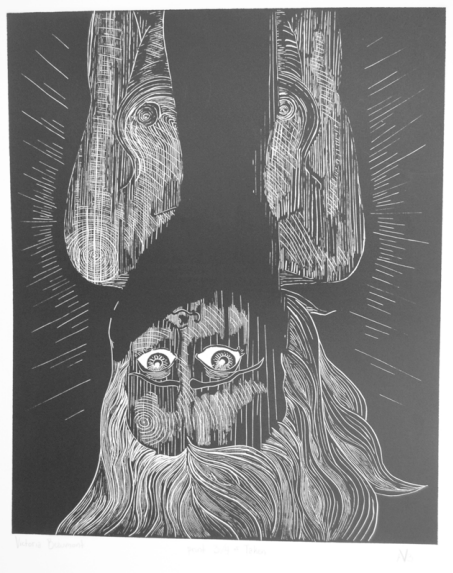By Jessica Wind (The Cascade) – Email
Print Edition: November 28, 2012
A student trying to create conversation around an uncomfortable topic didn’t factor in searching for her artwork as part of the process, which became a reality when it was removed from public display at Abbotsford Campus.
November 19 marked the last day of the exhibit in which visual arts student Victoria Beaumont shone a light on issues surrounding sexual abuse. The piece was a final project for Beaumont’s Print Media 1 class with Davida Kidd.
It began with the completion of a print, titled “Taken”, featuring a nude woman from the ribs up with a male’s hand covering her mouth. This was hung in four places on campus with a comment box for people to anonymously respond to the issues being raised in the piece.
The final stage was an exhibit titled “Don’t Be Silenced” in the art gallery located in C building. A couch was set in front of the pieces along with the anonymous comments. Beaumont arranged them in the shape of a thought bubble, accompanied by statistics on sexual abuse in Canada.
“Sexual abuse is often a suppressed topic, whether it be by society or personal admittance,” she explained. “I, personally, have experienced this and the piece became my way of standing up to it.”
Beaumont’s project was approved for display on campus and in the art gallery, but during the two-week long run, her pieces were removed and the doors often remained locked to the C building gallery space.
Davida Kidd, Beaumont’s instructor for the project, noted that there have been occasions when sensitive pieces have been removed from public viewing.
“Work has been taken down in the past; some forms of nudity have been objected to,” she said, adding that sometimes pieces are placed in the UFV art gallery with a sign on the door to warn audiences about mature content.
Kidd explained that students, in some situations, want a broader audience than the galleries in C and B building have to offer and therefore must go through approval of facilities.
Beaumont described her piece as something everyone on campus could respond to, and she wanted them to do so anonymously in response to her work.
“I strongly encouraged people to write about their experiences,” she said, adding that she sought and was given approval for the display from facilities.
Alan Stokes, director of facilities, confirmed that approval for art pieces goes through his department and noted that when a piece is removed it is a question of safety.
“The reason I get involved is for a safety factor. We don’t want to have any students or any public hurt in any way,” he explained.
He went on to note that during the time a piece is displayed on campus, it is monitored by the student artist.
“It’s not monitored by facilities or the university … it’s the responsibility of the student … to make sure it is still intact,” he explained.
Beaumont was checking on her pieces when she noticed they had been removed.
“When it was taken down I had to go in search of it,” she said. “Facilities called [the] janitorial [office] … my pieces were in [their] office; they’d been taken down.”
Stokes explained that facilities will notify faculty if a piece has been brought into question.
“It is not something we have deemed not acceptable … maybe someone else has brought it to the attention of … the institution and then it makes it down to our level,” Stokes explained. “We’ll present the concern and leave it to the faculty member.”
As to Beaumont’s concern that the doors to her gallery portion of the exhibit were frequently locked, Stokes responded by saying that the doors to the art galleries are managed by the visual arts department, not by facilities. No one in visual arts was available to comment directly on the removal of Beaumont’s piece.
Beaumont was frustrated that her piece, which relied on public response to be successful, was subject to so many complications.
“I almost always had to ask for the door to be opened,” she said. “It was interesting … the doors, in bold, read ‘Don’t Be Silenced.’”



